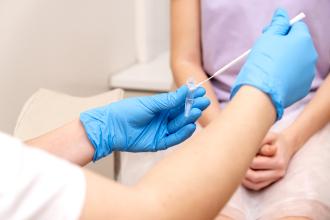The changing epidemiology of syphilis in BC
Rates of infectious syphilis in British Columbia have been steadily increasing over the past decade. In 2021, 1428 infectious syphilis cases were reported in BC (27.5 per 100 000 population, the highest on record in the last 40 years). Based on the number of reported cases in the first two quarters, infectious syphilis rates for 2022 are on track to be even higher.[1,2]
The majority of infectious syphilis cases in the past decade have been among gay, bisexual, and other men who have sex with men. However, the number and proportion of cases have been growing quickly among heterosexual populations in recent years. Currently, the majority of reported infectious syphilis cases occurred among non–gay, bisexual, and other men who have sex with men populations,[1] raising concern of increases in congenital syphilis.
Congenital syphilis is a severe, often debilitating, and potentially lethal infection that is the result of in utero transmission. Following zero reported cases of congenital syphilis in BC between 2014 and 2018, 12 cases of congenital syphilis, including 9 cases of early congenital syphilis,[3] were reported in BC from 2019 to 2022 quarter 2.[1] One resulted in stillbirth or neonatal loss.
Similarly, across Canada, infectious syphilis cases have risen by 124% from 2016 to 2020, and 50 congenital syphilis cases were reported in 2020.[4]
Syphilis screening recommendations
Syphilis clinical presentation, particularly secondary syphilis, can vary widely. Syphilis testing should be considered for all sexually active individuals presenting with new symptoms. Screening for syphilis and other sexually transmitted infections is recommended for individuals identifying risk factors, such as new sexual partners, or every 3–6 months for those with casual sexual partners.[5]
For pregnant individuals, syphilis screening is recommended in BC during the first trimester (or first prenatal visit) and at delivery (or anytime after week 35 for those planning home births).[5,6] Pregnant persons with ongoing risk, such as new sexual partners, transactional sex, illicit drug use, or unstable housing, should also be screened for syphilis at 28–32 weeks of pregnancy.[5]
People delivering a stillborn infant after 20 weeks’ gestation should be screened for syphilis.[5]
Congenital syphilis
Infants born to individuals without prenatal care or with syphilis should be assessed for congenital syphilis. Syphilis should also be considered in the differential diagnosis for unwell neonates. For consultation, please call the on-call pediatric infectious disease physician at BC Children’s Hospital (BCCH) at 604 875-2345. Outpatient follow-up of infants with probable or confirmed congenital syphilis is in partnership between local community pediatricians and the Oak Tree Clinic at BC Women’s Hospital.
In the event of a stillbirth or neonatal death, pathologists at BCCH are available (604 875-2345) for consultation regarding confirmation of congenital syphilis.
Treatment
Intramuscular penicillin G benzathine is the recommended treatment for infectious syphilis, including in pregnant individuals. In the case of penicillin allergy, desensitization to penicillin is recommended. Sexual partners exposed in the previous 3 months should be tested and treated, as it can take up to 3 months for syphilis to be diagnosed by serology.[7] Infants with possible or confirmed congenital syphilis require treatment with intravenous penicillin for 10 days. For information about syphilis screening or treatment, contact the BCCDC public health nurse at 604 707-5607 or physician at 604 707-5610.
—Jason Wong, MD, MPH, CCFP, FRCPC
BCCDC
—Melanie Murray, MD, PhD, FRCPC
BC Women’s Hospital
—Laura Sauvé, MD, MPH, FRCPC
BC Children’s Hospital
—Elaine Chan, MPH
BCCDC
—Julie van Schalkwyk, MD, FRCSC
BC Women’s Hospital
—Ann Pederson, PhD
BC Women’s Hospital
—Ellen Giesbrecht, MD
Perinatal Services BC
—Marianne Morgan, MD
Perinatal Unit, Kelowna General Hospital
—Muhammad Morshed, PhD, SCCM
BCCDC Public Health Laboratory
—Troy Grennan, MD, DTM&H, MSc, FRCPC
BCCDC
hidden
This article is the opinion of the BC Centre for Disease Control and has not been peer reviewed by the BCMJ Editorial Board.
 |
| This work is licensed under a Creative Commons Attribution-NonCommercial-NoDerivatives 4.0 International License. |
References
1. BC Centre for Disease Control. British Columbia syphilis indicators: 2022 Q2. Accessed 23 October 2022. www.bccdc.ca/resource-gallery/Documents/Statistics%20and%20Research/Statistics%20and%20Reports/STI/BC_syphilis_indicator_report_2022Q2_final.pdf.
2. BC Centre for Disease Control. Reportable diseases data dashboard: Syphilis (infectious), 2003 to 2019, all BC. Accessed 23 October 2022. www.bccdc.ca/health-professionals/data-reports/reportable-diseases-data-dashboard.
3. BC Centre for Disease Control. Syphilis: Case definition. Accessed 23 October 2022. www.bccdc.ca/health-professionals/clinical-resources/case-definitions/syphilis.
4. Public Health Agency of Canada. Infectious syphilis and congenital syphilis in Canada, 2020 (infographic). Accessed 23 October 2022. www.canada.ca/en/public-health/services/publications/diseases-conditions/infectious-syphilis-congenital-syphilis-canada-2020.html.
5. Public Health Agency of Canada. Syphilis guide: Screening and diagnostic testing. Updated 2022. Accessed 23 October 2022. www.canada.ca/en/public-health/services/infectious-diseases/sexual-health-sexually-transmitted-infections/canadian-guidelines/syphilis/screening-diagnostic-testing.html.
6. Perinatal Services BC. New recommendations for syphilis screening in pregnancy. Updated 3 September 2019. Accessed 23 October 2022. www.perinatalservicesbc.ca/about/news-stories/stories/new-recommendations-for-syphilis-screening.
7. BC Centre for Disease Control. British Columbia treatment guidelines: Sexually transmitted infections in adolescents and adults 2014. Accessed 23 October 2022. www.bccdc.ca/resource-gallery/Documents/Communicable-Disease-Manual/Chapter%205%20-%20STI/CPS_BC_STI_Treatment_Guidelines_20112014.pdf.

